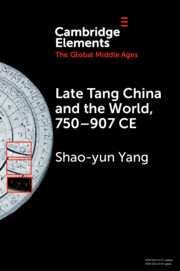50 results
11 - Race in the Global History of Europe
-
-
- Book:
- Globalizing Europe
- Published online:
- 06 March 2025
- Print publication:
- 13 March 2025, pp 159-180
-
- Chapter
- Export citation
Explaining the relationship between religiosity and anti-diversity attitudes among Christians in Western Germany
-
- Journal:
- Politics and Religion , First View
- Published online by Cambridge University Press:
- 25 February 2025, pp. 1-32
-
- Article
-
- You have access
- Open access
- HTML
- Export citation
Chapter 5 - Authority, Influence, and Power Politics
- from Part III - Power and Its Rewards
-
- Book:
- Ladies-in-Waiting in Medieval England
- Published online:
- 02 January 2025
- Print publication:
- 09 January 2025, pp 205-239
-
- Chapter
- Export citation
5 - Fear of Foreigners
-
- Book:
- Brexitspeak
- Published online:
- 22 November 2024
- Print publication:
- 05 December 2024, pp 103-125
-
- Chapter
- Export citation
Epilogue: Berlin is not Weimar
-
- Book:
- Germany through Jewish Eyes
- Published online:
- 14 November 2024
- Print publication:
- 21 November 2024, pp 221-226
-
- Chapter
- Export citation
4 - Racism in Hitler’s Shadow
- from Part II - Kicking out the Turks
-
- Book:
- Foreign in Two Homelands
- Published online:
- 31 August 2024
- Print publication:
- 31 October 2024, pp 177-226
-
- Chapter
-
- You have access
- Open access
- HTML
- Export citation
Salience of infectious diseases did not increase xenophobia during the COVID-19 pandemic
-
- Journal:
- Evolutionary Human Sciences / Volume 6 / 2024
- Published online by Cambridge University Press:
- 18 October 2024, e34
-
- Article
-
- You have access
- Open access
- HTML
- Export citation
2 - E Pluribus Unum: Citizenship, Demographic Change, and Diversity
- from Part I - Diversity and American Democracy
-
- Book:
- Race and Inequality in American Politics
- Published online:
- 09 November 2024
- Print publication:
- 17 October 2024, pp 34-69
-
- Chapter
- Export citation
Xenophobia in Juror Decision-Making
-
- Journal:
- Law & Social Inquiry , First View
- Published online by Cambridge University Press:
- 15 October 2024, pp. 1-25
-
- Article
-
- You have access
- Open access
- HTML
- Export citation
Chapter 24 - Border Crises
- from Part IV - Anxious Neighbourhoods, Uncertain Futures
-
-
- Book:
- Europe in British Literature and Culture
- Published online:
- 06 June 2024
- Print publication:
- 13 June 2024, pp 385-419
-
- Chapter
- Export citation
2 - Estranging English
-
- Book:
- Before the Word Was Queer
- Published online:
- 14 March 2024
- Print publication:
- 21 March 2024, pp 56-83
-
- Chapter
- Export citation
Chapter 6 - Anti-Fleming Sentiment and the Peasants’ Revolt of 1381
-
- Book:
- Flemish Textile Workers in England, 1331–1400
- Published online:
- 16 November 2023
- Print publication:
- 30 November 2023, pp 240-265
-
- Chapter
- Export citation
Chapter 4 - Libel, Equity, and Law in Sir Thomas More
- from Part II - Libels on the Elizabethan Stage
-
- Book:
- Libels and Theater in Shakespeare's England
- Published online:
- 05 October 2023
- Print publication:
- 19 October 2023, pp 115-143
-
- Chapter
- Export citation
Chapter 12 - Immigrant Fiction
- from Part II - The Politics of Genre and Form
-
-
- Book:
- The Cambridge Companion to the Twentieth-Century American Novel and Politics
- Published online:
- 07 October 2023
- Print publication:
- 12 October 2023, pp 189-204
-
- Chapter
- Export citation
3 - The Making of ‘Migrants’
-
- Book:
- Relative Distance
- Published online:
- 22 June 2023
- Print publication:
- 06 July 2023, pp 79-102
-
- Chapter
- Export citation
Chapter 6 - Xenophobia and Xenophilia
-
- Book:
- Writing, Politics and Change in South Africa after Apartheid
- Published online:
- 08 August 2023
- Print publication:
- 08 June 2023, pp 181-202
-
- Chapter
- Export citation
Shifting Patterns of Antisemitism in Latin America: Xenophobia, Exclusion, and Inclusion
-
- Journal:
- Latin American Research Review / Volume 58 / Issue 2 / June 2023
- Published online by Cambridge University Press:
- 09 May 2023, pp. 403-421
-
- Article
-
- You have access
- Open access
- HTML
- Export citation

Late Tang China and the World, 750–907 CE
-
- Published online:
- 05 May 2023
- Print publication:
- 25 May 2023
-
- Element
- Export citation
3 - Assam and the “Illegal” Other
-
- Book:
- India's Bangladesh Problem
- Published online:
- 30 March 2023
- Print publication:
- 06 April 2023, pp 103-143
-
- Chapter
- Export citation
12 - ‘I am no racist but …’
-
-
- Book:
- The Grammar of Hate
- Published online:
- 30 June 2022
- Print publication:
- 14 July 2022, pp 241-261
-
- Chapter
- Export citation


